Is it illegal to drive without shoes? Many drivers assume that going barefoot behind the wheel is against the law, but the reality is different. While safety experts often discourage it, no U.S. state actually bans barefoot driving.
In this guide, we’ll elaborate on is it illegal to Drive Without Shoes or not. We’ll separate myth from fact, explain the actual laws, discuss potential safety concerns, and offer tips to stay comfortable and in control on the road. By the end, you’ll know exactly when barefoot driving is safe—and when it might cause issues.
Is It Illegal to Drive Without Shoes? Facts Explained
No, it’s not illegal to drive without shoes in any state of the USA. Rather, you should drive wearing proper shoes because it is unsafe to drive barefoot. Still many people think it’s illegal. So what’s really the truth?
1. Is It Illegal to Drive Without Shoes in the USA?
If you’ve ever wondered whether you can legally drive barefoot, the short answer is: yes, it’s legal. In the United States, there is no law in any state that prohibits driving without shoes. That means whether you’re in Texas, California, Florida, New York, or anywhere else, you can legally operate a vehicle barefoot.
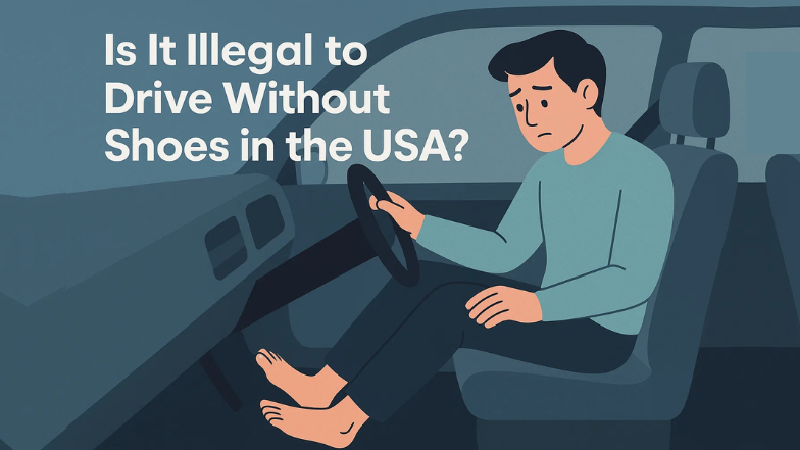
Are There Any Exceptions?
Some people ask, “What states is it illegal to drive without shoes?” The answer is simple: none. Every state allows barefoot driving, so you won’t be breaking the law by taking off your shoes behind the wheel.
Legality vs. Safety
Just because driving barefoot is legal doesn’t mean it’s always safe. Safety concerns include:
- Reduced pedal control:
Bare feet may slip off pedals more easily than shoes with a proper grip.
- Emergency situations:
Sudden braking or quick maneuvering might be harder without footwear.
- Injury risk:
Bare feet are more susceptible to cuts, burns, or bruises if you shift your foot abruptly. Also if your shoes are slippery, you can’t get a good grip. This is when accidents happen the most.
While legality isn’t an issue, it’s important to consider comfort and safety before deciding to drive barefoot. We’ll cover tips for safe driving without shoes in the next sections.
2. Why Do People Think It’s Illegal to Drive Barefoot?
Many drivers mistakenly believe that driving barefoot is against the law, but this is simply a common misconception. Several factors contribute to this myth:
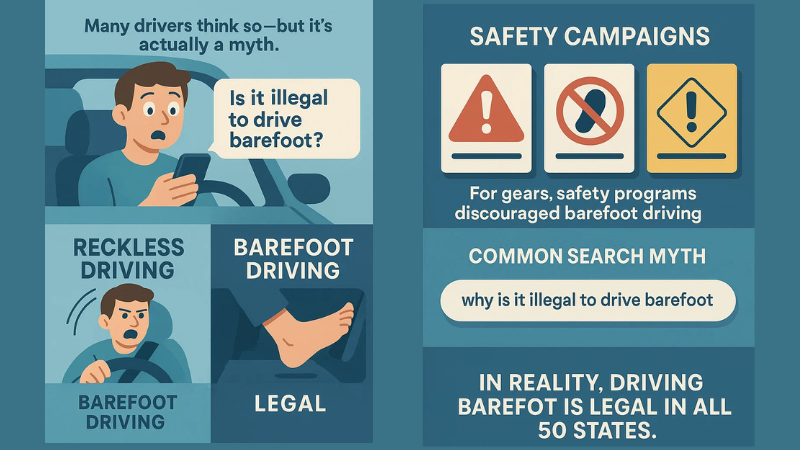
Safety Campaigns and Warnings
For years, driving safety programs have discouraged barefoot driving, highlighting that shoes can provide better grip and control on pedals. While these campaigns focus on safety, some people misinterpret the advice as a legal restriction.
Confusion With Unsafe Driving Laws
Some drivers confuse barefoot driving with laws against unsafe or negligent driving. While being careless, distracted, or reckless behind the wheel is illegal, barefoot driving alone is not a violation of any traffic law in the United States.
Common Search Queries
Keywords like why is it illegal to drive without shoes or why is it against the law to drive without shoes frequently appear in online searches. People often assume the worst, thinking that barefoot driving might result in fines or penalties—but in reality; it’s perfectly legal in all U.S. states.
3. Safety Concerns About Driving Barefoot
Even though driving barefoot is completely legal, it can come with certain safety risks. Shoes provide grip, protection, and stability, which your bare feet may lack, especially during sudden maneuvers or emergencies.
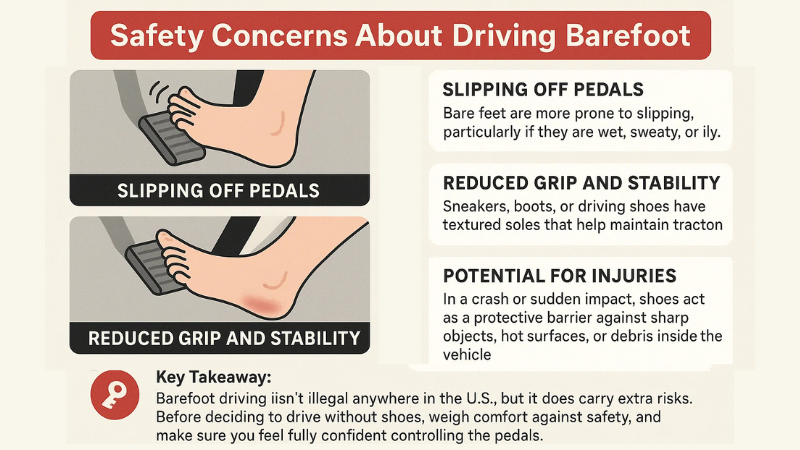
Slipping Off Pedals
Bare feet are more prone to slipping, particularly if they are wet, sweaty, or oily. This can reduce your control over the brake, accelerator, or clutch, making quick reactions more difficult and potentially increasing the risk of an accident.
Reduced Grip and Stability
Footwear such as sneakers, boots, or driving shoes have textured soles that help maintain traction on pedals. But this doesn’t mean that your wet shoes will also work. If your shoes get wet, you should dry them quickly first and then proceed to drive. Without shoes, your feet may slide or shift, especially if they are wet. During long drives or when performing precise maneuvers, these decrease overall stability behind the wheel.
Potential for Injuries
In the event of a collision or sudden impact, shoes protect your feet from sharp objects, hot surfaces, or debris inside the vehicle. Bare feet are more vulnerable to cuts, burns, or bruises, which could complicate an emergency situation.
Key Takeaway
Barefoot driving isn’t illegal in any U.S. state, but it can increase the risk of accidents and minor injuries. Before deciding to drive without shoes, carefully consider comfort versus safety, and ensure you feel confident controlling the pedals.
4. When Barefoot Driving Could Lead to Legal Issues
While driving barefoot is legal across all U.S. states, there are certain situations where it could indirectly result in legal complications. Understanding these scenarios can help you make safer choices behind the wheel.
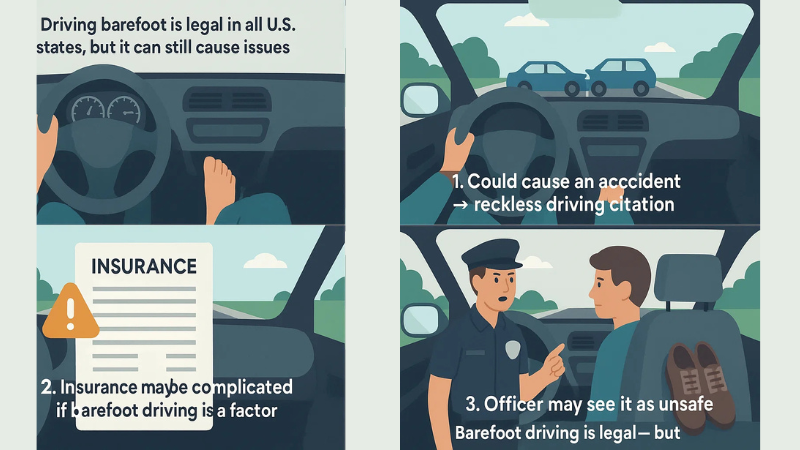
Contributing to an Accident
If driving without shoes causes you to lose control of the vehicle and results in a crash, you could potentially be cited for careless or reckless driving. The law focuses on the outcome—unsafe operation of a vehicle—rather than the act of being barefoot itself.
Insurance Considerations
Some insurance companies may review claims more closely if barefoot driving played a role in an accident. While it doesn’t automatically void coverage, negligence related to pedal control could complicate your claim.
Officer Discretion
In rare instances, a police officer might consider barefoot driving a distraction or unsafe practice during a traffic stop. While this alone isn’t illegal, it could factor into an officer’s assessment if other traffic violations are present.
Key Takeaway
Driving barefoot itself isn’t illegal anywhere in the U.S., but it should never compromise your safety or the safety of others. Maintaining proper control of your vehicle is essential; failing to do so could result in fines, legal liability, or insurance complications.
Alternatives to Driving Barefoot
If you enjoy the feeling of driving barefoot but want to stay safe, there are practical alternatives that provide comfort without compromising control over the pedals.
1. Keep a Spare Pair of Driving Shoes in Your Car
Having a lightweight pair of sneakers, flats, or slip-on shoes in your vehicle makes it easy to put on footwear before driving. Make sure that the shoes you choose are the most comfortable and safe for driving. You can wear your preferred shoes while walking or at work, then switch to these comfortable, safe driving shoes whenever you hit the road.
2. Opt for Thin-Soled Shoes for Better Pedal Sensitivity
Shoes with flexible, thin soles allow your feet to feel the pedals more accurately than thick boots or stiff footwear. This improves braking precision and acceleration control while keeping your feet protected.
3. Avoid Risky Footwear
Certain shoes can increase the risk of accidents due to poor grip or instability:
- Flip-flops or slippery sandals can easily slide off pedals.
- High heels can catch or impede smooth pedal movement.
Choosing safe, low-profile footwear helps maintain full control and confidence while driving.
Practical Tip:
Consider keeping a small shoe bag or compartment in your car specifically for driving shoes. This ensures they are always clean, accessible, and ready to use whenever you need them.
By using these alternatives, you can enjoy comfort and freedom while driving safely, avoiding the risks associated with going completely barefoot.
Conclusion
To recap, driving barefoot is legal in every U.S. state. Despite common misconceptions, there is no law prohibiting barefoot driving, so you won’t face fines simply for taking off your shoes behind the wheel.
However, the primary concern isn’t legality—it’s safety. Bare feet can:
- Slip off pedals, reducing control over braking and acceleration.
- Provide less grip, making precise pedal movement more difficult.
- Offer minimal protection in the event of an accident, leaving your feet vulnerable to injuries.
- For safer driving, consider simple strategies:
- Keep a spare pair of thin-soled shoes in your car for quick use.
- Avoid risky footwear such as flip-flops, high heels, or slippery sandals.
- Choose flexible shoes that allow pedal sensitivity while protecting your feet.
By prioritizing both comfort and control, you can drive confidently—whether you prefer to go barefoot or wear shoes. With the right precautions, you can enjoy the freedom of barefoot driving without compromising safety.
FAQs About Driving Barefoot
Is it illegal to drive barefoot in Texas, California, or Florida?
No. Driving barefoot is legal in all U.S. states, including Texas, California, and Florida. No state has laws prohibiting it.
Can you get a ticket for driving without shoes?
Not for being barefoot alone. However, if barefoot driving contributes to unsafe driving or an accident, you could be cited for careless or reckless driving.
Why is driving barefoot considered dangerous?
Bare feet can slip off pedals, provide fewer grips, and offer minimal protection in case of an accident. It’s legal, but safety experts caution against it.
Is it illegal to drive with sandals or flip-flops?
No, but flip-flops and loose sandals can slip or get caught in pedals, which makes them less safe than closed, thin-soled shoes.
What footwear is safest for driving?
The safest options are flat, closed shoes with good grip, such as sneakers or driving shoes. They offer control, comfort, and protection.

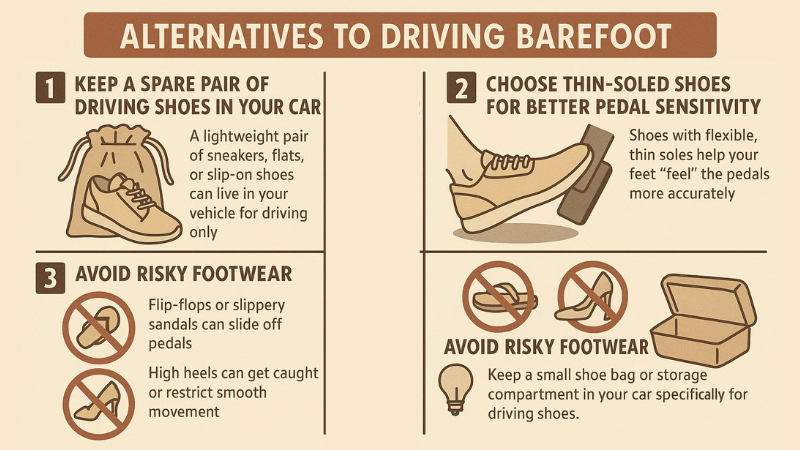
Leave a Reply